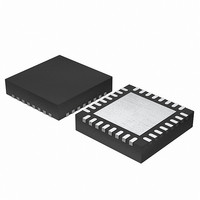EFM32G200F16 Energy Micro, EFM32G200F16 Datasheet - Page 321

EFM32G200F16
Manufacturer Part Number
EFM32G200F16
Description
MCU 32BIT 16KB FLASH 32-QFN
Manufacturer
Energy Micro
Series
Geckor
Datasheets
1.EFM32G200F16.pdf
(63 pages)
2.EFM32G200F16.pdf
(10 pages)
3.EFM32G200F16.pdf
(463 pages)
4.EFM32G200F16.pdf
(136 pages)
Specifications of EFM32G200F16
Core Processor
ARM® Cortex-M3™
Core Size
32-Bit
Speed
32MHz
Connectivity
EBI/EMI, I²C, IrDA, SmartCard, SPI, UART/USART
Peripherals
Brown-out Detect/Reset, DMA, POR, PWM, WDT
Number Of I /o
24
Program Memory Size
16KB (16K x 8)
Program Memory Type
FLASH
Ram Size
8K x 8
Voltage - Supply (vcc/vdd)
1.8 V ~ 3.8 V
Data Converters
A/D 4x12b, D/A 1x12b
Oscillator Type
External
Operating Temperature
-40°C ~ 85°C
Package / Case
32-VQFN Exposed Pad
Processor Series
EFM32G200
Core
ARM Cortex-M3
Data Bus Width
32 bit
Data Ram Size
8 KB
Interface Type
I2C, UART
Maximum Clock Frequency
32 MHz
Number Of Programmable I/os
24
Number Of Timers
2
Operating Supply Voltage
1.8 V to 3.8 V
Maximum Operating Temperature
+ 85 C
Mounting Style
SMD/SMT
Minimum Operating Temperature
- 40 C
Lead Free Status / RoHS Status
Lead free / RoHS Compliant
Eeprom Size
-
Lead Free Status / Rohs Status
Details
- EFM32G200F16 PDF datasheet
- EFM32G200F16 PDF datasheet #2
- EFM32G200F16 PDF datasheet #3
- EFM32G200F16 PDF datasheet #4
- Current page: 321 of 463
- Download datasheet (8Mb)
23.3 Functional Description
23.3.1 Warm-up Time
2010-09-06 - d0001_Rev1.00
• Comparator output direct on PRS
• Comparator output on GPIO through alternate functionality
An overview of the ACMP is shown in Figure 23.1 (p. 321) .
Figure 23.1. ACMP Overview
The comparator has two analog inputs, one positive and one negative. When the comparator is active,
the output indicates which of the two input voltages is higher. When the voltage on the positive input is
higher than the voltage on the negative input, the digital output is high and vice versa.
The output of the comparator can be read in the ACMPOUT bit in ACMPn_STATUS. It is possible to
switch inputs while the comparator is enabled, but all other configuration should only be changed while
the comparator is disabled.
The analog comparator is enabled by setting the EN bit in ACMPn_CTRL. When this bit is set, the
comparator must stabilize before becoming active and the outputs can be used. This time period is called
the warm-up time. The warm-up time is a configurable number of peripheral clock (HFPERCLK) cycles,
set in WARMTIME, which should be set to at least 10 µs. When the comparator is enabled and warmed
up, the ACMPACT bit in ACMPn_STATUS will indicate that the comparator is active. The output value
when the comparator is inactive is set to the value in INACTVAL in ACMPn_CTRL (see Figure 23.1 (p.
321) ).
An edge interrupt will be generated after the warm-up time if edge interrupt is enabled and the value set
in INACTVAL is different from ACMPOUT after warm-up.
One should wait until the warm-up period is over before entering EM2 or EM3, otherwise no comparator
interrupts will be detected. EM1 can still be entered during warm-up. After the warm-up period is
completed, interrupts will be detected in EM2 and EM3.
• Output inversion available
ACMPn_CH0
ACMPn_CH1
ACMPn_CH2
ACMPn_CH3
ACMPn_CH4
ACMPn_CH5
ACMPn_CH6
ACMPn_CH7
0000
1011
000
111
-
-
BIASPROG
HALFBIAS
FULLBIAS
HYSTSEL
POSSEL
NEGSEL
EN
V
DD_SCALED
VDDLEVEL
Warm -up
counter
Scaler
...the world's most energy friendly microcontrollers
321
V
2.5 V
1.25 V
INACTVAL
DD
ACMPACT
LPREF
1
0
GPIOINV
Read/Write registers
Read only registers
Warm up interrupt
Edge interrupt
Output to PRS
Output to GPIO
ACMPOUT
www.energymicro.com
Related parts for EFM32G200F16
Image
Part Number
Description
Manufacturer
Datasheet
Request
R

Part Number:
Description:
KIT STARTER EFM32 GECKO
Manufacturer:
Energy Micro
Datasheet:

Part Number:
Description:
KIT DEV EFM32 GECKO LCD SUPPORT
Manufacturer:
Energy Micro
Datasheet:

Part Number:
Description:
BOARD PROTOTYPING FOR EFM32
Manufacturer:
Energy Micro
Datasheet:

Part Number:
Description:
KIT DEVELOPMENT EFM32 GECKO
Manufacturer:
Energy Micro
Datasheet:

Part Number:
Description:
MCU, MPU & DSP Development Tools TG840 Sample Kit
Manufacturer:
Energy Micro
Datasheet:

Part Number:
Description:
MCU, MPU & DSP Development Tools TG Starter Kit
Manufacturer:
Energy Micro
Datasheet:

Part Number:
Description:
MCU, MPU & DSP Development Tools TG108 Sample Kit
Manufacturer:
Energy Micro

Part Number:
Description:
MCU, MPU & DSP Development Tools TG210 Sample Kit
Manufacturer:
Energy Micro
Datasheet:

Part Number:
Description:
MCU, MPU & DSP Development Tools TG822 Sample Kit
Manufacturer:
Energy Micro
Datasheet:

Part Number:
Description:
MCU, MPU & DSP Development Tools TG230 Sample Kit
Manufacturer:
Energy Micro

Part Number:
Description:
SAMPLE KIT (SMALL BOX - CONTAINING 2 DEVICES)
Manufacturer:
Energy Micro

Part Number:
Description:
SAMPLE KIT (SMALL BOX - CONTAINING 2 DEVICES)
Manufacturer:
Energy Micro










